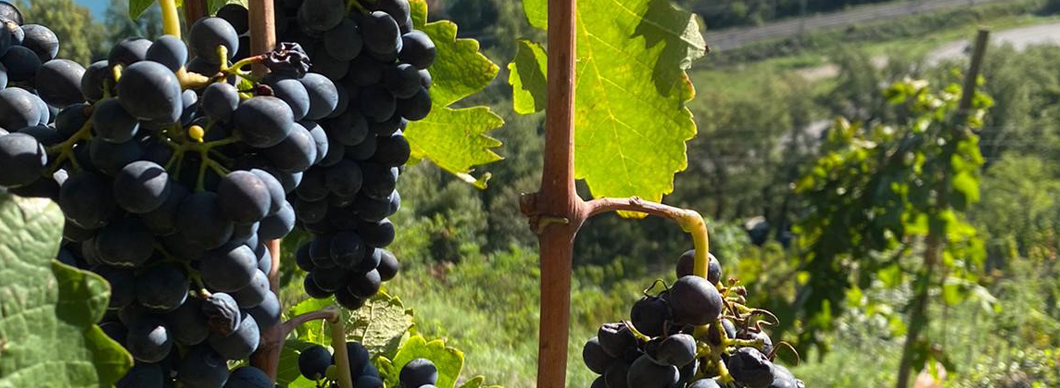By Tiffany Vernon
Approx time to read: 6 minutes 30 seconds
It is likely that many of you will already be familiar with Syrah being a major star in the Rhône Valley, France. In fact, in the Northern Rhône, in subregions such as Hermitage and Côte-Rôtie, it is the only permitted red grape variety. For others, you may be more au fait with the name Shiraz, made famous by Australian winegrowers.
Whichever name you prefer, there is no denying its popularity across the globe. So, if you wish to get your ‘wine-geek’ on and delve a little deeper, keep reading for this deep dive on Syrah… Sorry, or Shiraz.
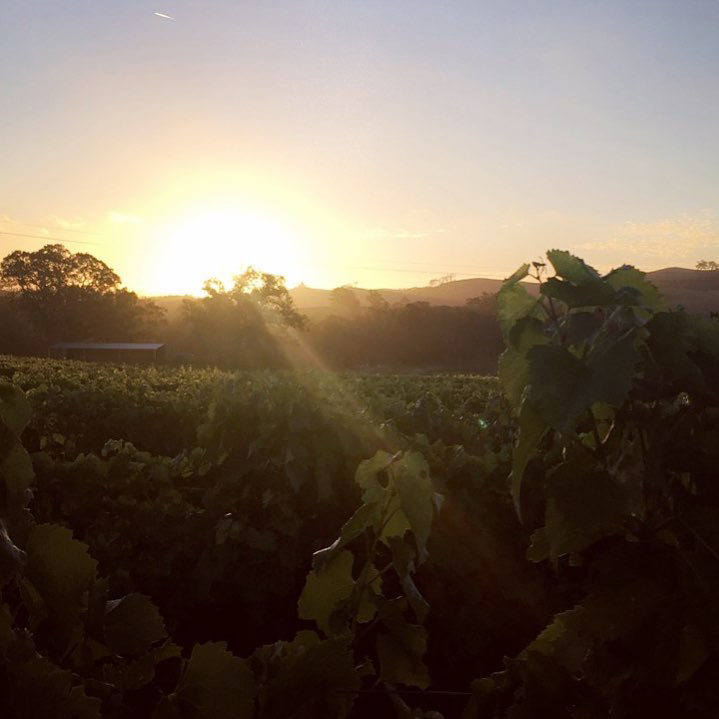
Vines at Barossa Boy in Barossa Valley, Australia
Once upon a time…
There are several theories as to the origins of Syrah, many of which are based purely on naming similarities. For example, one hypothesis notes the city of Shiraz in ancient Persia was once an important wine epicentre, so it wouldn’t seem far-fetched to suggest this grape possibly originated here (or is it?). Some believed the grape was introduced to southern France from Persia by the Phocaeans in 600 BC, whilst others think it was taken to the Rhône Valley by Crusaders between 1095 and 1291. This would also suggest that the Australians have maintained the original name for the grape – Shiraz. There are a few holes in this theory, however, such as the Crusaders being rather focused on travelling to the Holy Land and not reaching Persia.
Although the ‘Persian Legend’ remains a popular theory, extensive research and grape DNA profiling means we have a pretty good idea of who Syrah’s parents are, and they aren’t from the Middle East. The first is Mondeuse Blanche, a variety from Savoie, and the second is Dureza, an Ardèche variety. This indicates that for the parent varieties to cross-pollinate, they must have been cultivated in the same area. Therefore, we can conclude it is very likely this took place in the Rhône-Alps region, where Syrah continues to grow today.
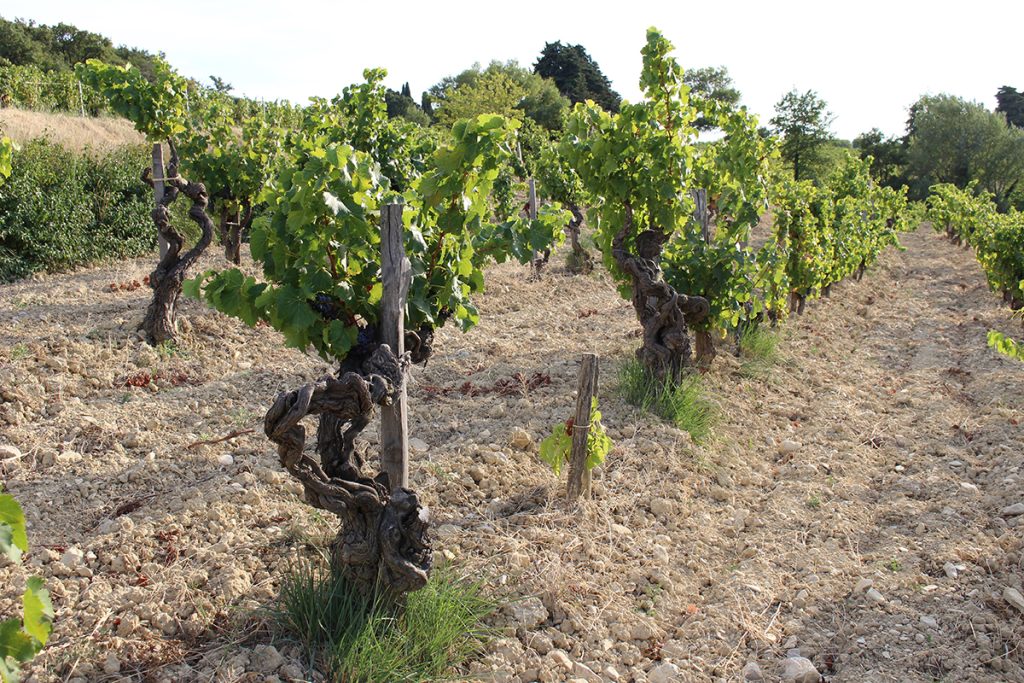
Old vines at Domaine Gourt de Mautens in Rasteau, Rhône Valley
Characteristics
Syrah can often be recognised by floral, typically violet, notes on the nose and a distinct peppery character, the potency of which very much depends on the vineyard’s terroir, growing conditions and the winemaker’s influence. Fruit characteristics are largely clustered around black fruit such as blackberries, black cherries and blackcurrants, but smoky, leathery and savoury notes with liquorice accents can develop with age.
Despite Syrah’s name having connotations of being late-ripening – the Latin word Serus roughly translates as late-ripening, from which the name Syrah is believed to have derived – it is actually a mid-ripening variety with a short window for both véraison and harvesting.
Aside from some of the more common diseases and pests found in vineyards, such as chlorosis, mites and botrytis bunch rot, Syrah is also susceptible to a more unusual plague of unknown cause. The so-called Syrah/ Shiraz disease (sometimes referred to as Syrah Decline) causes the vine trunk to swell and crack before the fruit production rapidly reduces and the vine eventually dies. Another curious phenomenon with this disease is the premature reddening of the vine leaves – of course, there have been many occasions that this has been mistaken for the vines simply transitioning into autumn! Adding to the mystery, this disease only affects Syrah vines and has been documented to occur almost everywhere it is grown, except for in Australia.

Terraced vineyards in the Rhône-Alps region
Countries and Regions
Considered an ‘international’ variety, Syrah can be found in most vine-growing areas worldwide. From some unsurprising contenders, such as Italy, Spain, California, New Zealand and South Africa, to the more unusual areas like Cyprus, Hawaii and Peru. However, so as not to bore you too much, I will focus on the two main areas.
Firstly, the historic home: Rhône Valley. The northern half of the region is where Syrah truly shines in its mono-varietal offerings. The granite rock of Hermitage represents a robust and concentrated style of Syrah known for its longevity and opulent fruit character, while Crozes-Hermitage (grown at the foot of the Hermitage hill) offers a softer and earlier-maturing version. The roasted slope of Côte-Rôtie, with its steeply terraced vineyards, typically produces fresher and lighter reds, which are considered the purest expression of Syrah. A small percentage (up to 15%) of Viognier is permitted in Côte-Rôtie wines to lift the aromatics.
In the Southern Rhône, Syrah shares its spotlight with other local varieties, most notably Grenache and Mourvèdre – making the famous ‘GSM’ blend of the region. In subregions such as Châteauneuf-du-Pape, Syrah can be blended with up to 17 different permitted grape varieties, which includes a mixture of red and white grapes.
Moving to Syrah’s second home: Australia. Initially known as Scyras, the grape was believed to have been introduced to the country from Montpellier in 1832 by James Busby. It blossomed marvellously in New South Wales and was subsequently rolled out to other winegrowing areas. It wasn’t long before Australia regarded Shiraz as their national red grape, and it still represents the most planted variety in the country today.
The oldest vines are in Barossa Valley, where many low-yielding veteran Shiraz are well over a century old! Capable of producing intense, long-lived and spicy reds, some of Australia’s most famous wines come from these gnarly vines. Other highly prized subregions include Eden Valley (a rival to the Barossa!), Clare Valley (giving textured styles), McLaren Vale (rich and aromatic) and Hunter Valley (with a particular savoury note). The Canberra District, Western Australia, takes inspiration from the hallowed Côte-Rôtie and typically blends Shiraz with a splash of Viognier; this soon became a fashionable alternate style for many other Aussie winemakers too. A Shiraz/ Cabernet Sauvignon blend is also hugely popular across Australia and has been adopted by other countries.
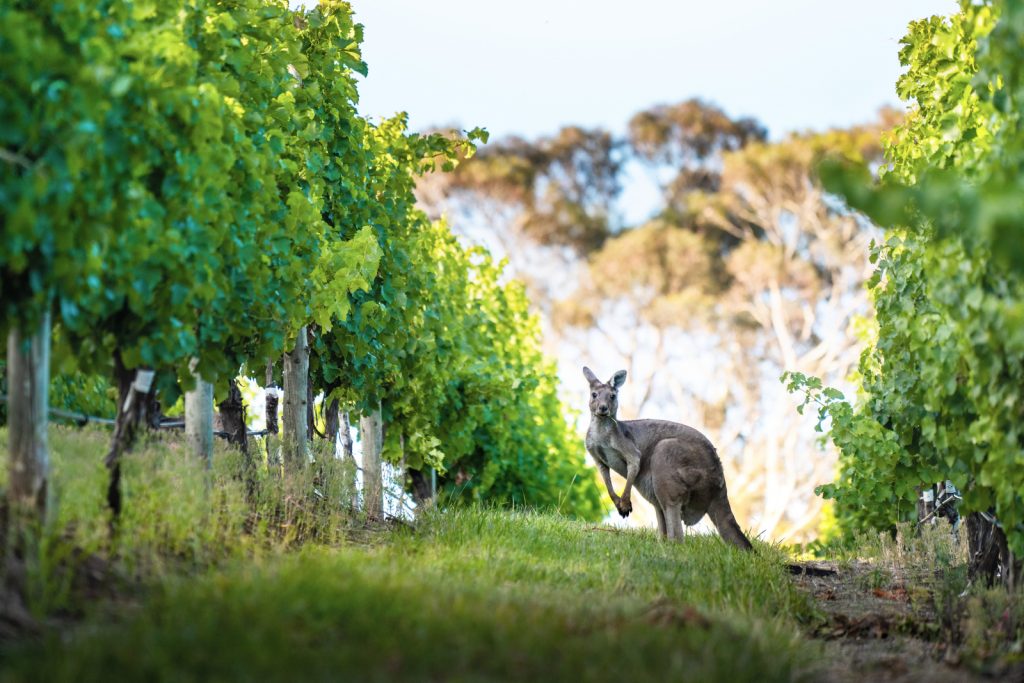
Kangaroo in vineyards at The Lane in Adelaide Hills, Australia
Styles
The French style and Australian style feel quite distinctive from one another, resulting in many wine producers labelling their wines as either Syrah or Shiraz to indicate the flavours within.
Although Australia can be culprit of producing jammy, bold and spiced Shriaz – they pack a punch but lack a little depth, although many consumers and wine critics alike fell hard for this modern style – they also create some fabulously complex examples. Bottles stamped as Shiraz indicate you’ll be enjoying a rich red with an emphasis on fruit flavours, accented by chocolate notes and a sprinkling of spice.
On the other hand, if you’re about to pick up a bottle labelled Syrah, you could probably expect a more brooding style that offers up floral perfume and savoury undertones, all framed by that hallmark black pepper.
Food Pairings
Syrah’s warmth, velvety texture and rich flavours make for many perfect pairings – which is possibly the reason for this wine’s popularity!
Densely fruited Australian styles pair well with rich and smokey dishes – think barbecue and chargrilled flavours! Particular highlights include steak and game or mushroom burgers and spiced falafel.
For a more French Syrah approach, a traditional roast dinner is a great partner, as is a charcuterie board, ribs, burgers or grilled vegetables.
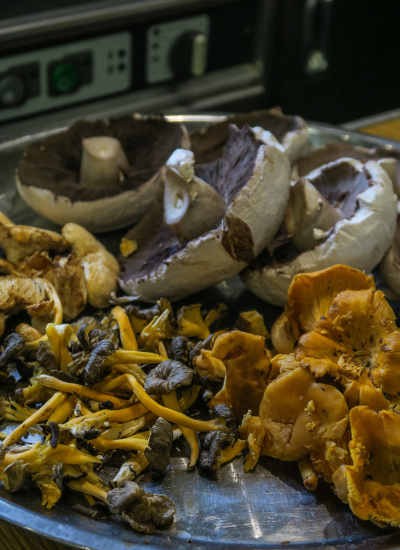
Syrah is a great match to mushroom dishes
Did you know…?
- Syrah is often referred to as Hermitage, particularly in Australia. To make things extra confusing, however, ‘Hermitage’ is also a synonym of the grape Cinsault, often found in South Africa. This is why the famous South African crossing of Pinot Noir and Cinsault was named ‘Pinotage’.
- In the Rhône Valley, many growers believe there are two distinct variants of Syrah – the superior smaller-berried version is known as Petite Syrah and the larger berry variant is Grosse Syrah. However, it is not related to North America’s Petite Sirah, which is an entirely different grape.
- Syrah is one of the oldest wine grapes in the world, with records of its plantings dating back to the 1st century, potentially even earlier!
- Most plantings can be found in its native France, with Australia being the second largest area planted with Syrah.
- Syrah is believed to be Pinot’s great-grandchild and Viognier’s sibling – no wonder they work well together!
Explore all Syrah/Shiraz wines here

